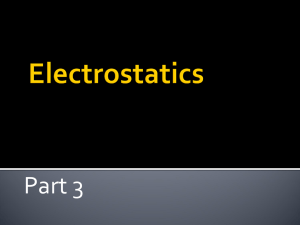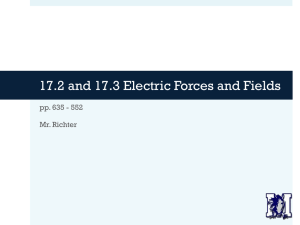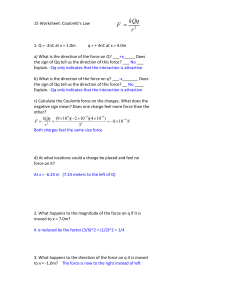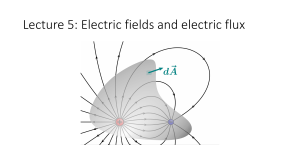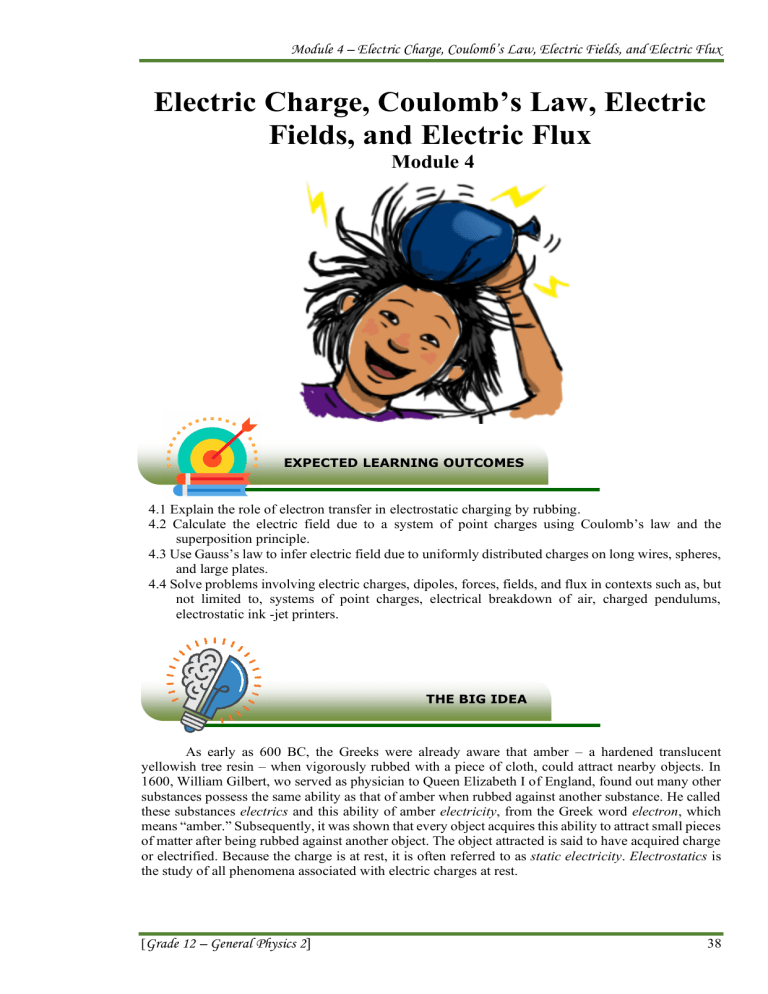
Module 4 – Electric Charge, Coulomb’s Law, Electric Fields, and Electric Flux Electric Charge, Coulomb’s Law, Electric Fields, and Electric Flux Module 4 EXPECTED LEARNING OUTCOMES 4.1 Explain the role of electron transfer in electrostatic charging by rubbing. 4.2 Calculate the electric field due to a system of point charges using Coulomb’s law and the superposition principle. 4.3 Use Gauss’s law to infer electric field due to uniformly distributed charges on long wires, spheres, and large plates. 4.4 Solve problems involving electric charges, dipoles, forces, fields, and flux in contexts such as, but not limited to, systems of point charges, electrical breakdown of air, charged pendulums, electrostatic ink -jet printers. THE BIG IDEA As early as 600 BC, the Greeks were already aware that amber – a hardened translucent yellowish tree resin – when vigorously rubbed with a piece of cloth, could attract nearby objects. In 1600, William Gilbert, wo served as physician to Queen Elizabeth I of England, found out many other substances possess the same ability as that of amber when rubbed against another substance. He called these substances electrics and this ability of amber electricity, from the Greek word electron, which means “amber.” Subsequently, it was shown that every object acquires this ability to attract small pieces of matter after being rubbed against another object. The object attracted is said to have acquired charge or electrified. Because the charge is at rest, it is often referred to as static electricity. Electrostatics is the study of all phenomena associated with electric charges at rest. [Grade 12 – General Physics 2] 38 Module 4 – Electric Charge, Coulomb’s Law, Electric Fields, and Electric Flux DEEPEN YOUR UNDERSTANDING CONDUCTORS AND INSULATORS Charges can exist in materials and move through them. However, the ease with which charges move through them differs. Conductivity is the measure of the ease at which an electric charge moves through a material. Materials that readily allow the flow of charges through them are called conductors. Metals are good conductors because they have plenty of free electrons that can easily move in the material. Insulators are materials that resist the flow of charges. The conductivity of insulators is low. Some examples of insulators are rubber, plastic, mica, paper, glass, and air. Semiconductors are intermediate between conductors and insulators. Semiconductors are not as conductive as metals, but they are more conducive than insulators such as rubber, plastic, and mica. The conductivity of a semiconductor in its pure form is incredibly low. Atoms of different elements in small amounts, (i.e., one part per million or even less) are added to pure semiconductors to improve their conductivity. This process is referred to as doping. Semiconductors have paved the way for the development of miniaturized electronic devices such as transistors and integrated circuits. Some examples of semiconductors are silicon, germanium, and gallium arsenide. Superconductors offer practically no resistance to the flow of charges below some critical temperatures. A current in a superconductor can keep flowing without any decay. In 1911, Dutch physicist Heike Kamerlingh Onnes discovered superconductivity by cooling mercury to a temperature of about 4 K. Most superconductors only work at temperatures close to absolute zero. Scientists are now focused on developing superconductors that will work at normal and high temperatures because superconductors that work at room temperature would make everyday electricity generation and transmission vastly more efficient in as much as there will be no power losses. The highest known critical temperature of a superconducting material is 203 K(–70°C); the material involved is hydrogen sulfide. CHARGING BY RUBBING Conductors are materials that allow electrical charges to move from one material to another. Conductors may be charged through different methods – rubbing, conduction, and induction. An electricity-neutral body can gain a charge by rubbing or friction. Consider two different uncharged bodies. Because of the difference in their material composition, the Fig. 4.1 Both the glass rod and silk cloth become electrically nuclei of their atoms pull their electrons with charged after rubbing them together. different strengths. Rubbing these two bodies will force their atoms to interact with one another, resulting in the “ripped-off” electrons are then transferred to the other body. After rubbing, one of the bodies will have more electrons, and the other one will have fewer. Thus, both will now be electrically charged. An example of charging by rubbing is shown in Figure 4.1. A glass rod acquires a positive charge after being rubbed with silk cloth, and silk cloth acquires a negative charge. Charging by rubbing also explains why we experience a weak electric shock when we suddenly touch a metallic object after walking on a carpeted floor. The charge acquired by rubbed materials can be determined using the triboelectric series. The triboelectric series is a list of common materials that were experimented on and found to behave in a predictable way. When these materials are rubbed together, those that appear first in the list tend to lose their electrons, making the negative. In other words, if you rub any two of the materials in the series, [Grade 12 – General Physics 2] 39 Module 4 – Electric Charge, Coulomb’s Law, Electric Fields, and Electric Flux the material in the upper part of the list will be positive, and the other material in the lower part will be negative. COULOMB’S LAW Through experimentation, Coulomb discovered that the magnitude of the electrical force between two charged particles is directly proportional to the product of the magnitudes of the charges and inversely proportional to the square of the distance between them. This statement is called Coulomb’s law. Mathematically, this can be written as |q1q2| Eq. (4.1) FE = k r2 where FE is the magnitude of the electric force in newtons, q1 and q2 are charges in coulombs, r is the distance in meters, and k is the proportionality constant called Coulomb’s constant with an approximate value of 9×109 N·m2/C2. Note that only the absolute value of the product of q1 and q2 is determined because only the magnitude of the force is to be computed. The force magnitude F is always positive. However, the electric force F is a vector quantity, which may be positive or negative depending on its direction. Its direction is along the line joining q1 and q2. The vectors representing the force that q1 exerts on q2 and vice versa are pointing toward each other for attraction and away from each other for repulsion. These forces are equal but opposite in direction in accordance with Newton’s third law of motion. Coulomb’s law bears a strong resemblance to Newton’s law of universal gravitation. Both equations have the same form. Recall that the gravitational force FG between two masses m1 and m2 is given by m1m2 Eq. (4.2) FG = G r2 where G is the universal gravitational constant approximately equal to 6.674×10 –11 N·m2/kg2. The electric force and the gravitational force have similarities and differences. Both forces follow the inverse square law for distance. Both forces are also proportional to the product of the quantity that causes the force, that is, mass for gravitational force and charge for electric force. Lastly, both forces are conservative and noncontact. However, the gravitational force is only an attractive force, while the electric force may be attractive or repulsive. The gravitational force, in general, is much weaker than the electric force. Example: Two protons (q = 1.602×10–19 C) are separated by 3.8×10–10 m in the air. (a) Find the magnitude of the electric force one proton exerts on the other. Is this force attractive or repulsive? (b) Find the magnitude of the gravitational force one proton exerts on the other. Is this force attractive or repulsive? Solution: (a) Using Eq. 4.1 to solve for the electric force and substituting values, |q1q2| |(1.602×10–19 C)(1.602×10–19 C)| 9 2 2 = (9×10 N·m /C ) r2 (3.8×10–10 m)2 –9 –9 FE = 1.596×10 N ≈ 2×10 N This is a repulsive force because the charges are both protons. (b) Using Eq. 4.2 to solve for the gravitational force and substituting values, FE = k (1.673×10–27 kg)2 m1m2 –11 2 2 = (6.674×10 N·m /kg ) r2 (3.8×10–10 m)2 –45 FG = 1.29×10 N Gravitational force is an attractive force. FG = G Example: Two small conducting and identical spheres A and B have charges –25 nC and +15 nC, respectively. They are separated by 0.02 m distance. (a) What is the magnitude of the electric force between the two spheres? Is this force attractive or repulsive? (b) The spheres are then allowed to touch each other and then separated. What is the magnitude of the force between the two spheres? Is this a repulsive force or an attractive force? [Grade 12 – General Physics 2] 40 Module 4 – Electric Charge, Coulomb’s Law, Electric Fields, and Electric Flux Solution: (a) Using Eq. 4.1 to solve for the electric force and substituting values, |q1q2| |(–25×10–9 C)(+15×10–9 C)| = (9×109 N·m2/C2) FE = k 2 r (0.02 m)2 –3 FE = 8.44×10 N Since the two charged spheres have unlike charges, the electric force is attractive. (b) Since spheres A and B are identical, they will share the net charge equally. q0A + q0B (–25×10–9 C)+(15×10–9 C) qA = qB = = –5×10–9 C = 2 2 Using Eq. 4.1 and substituting values, |qAqB| |(–5×10–9 C)( –5×10–9 C)| 9 2 2 = (9×10 N·m /C ) FE = k r2 (0.02 m)2 FE = 5.63×10–3 N Since the two charged particles have like charges, the electric force between them is repulsive. SUPERPOSITION PRINCIPLE So far, only the force between two-point charges has been discussed. What if there are more than two charges? For instance, if there are three charges q1, q2, and q3, what will be the net force on q1 due to q2 and q3? Electric forces obey the superposition principle. The superposition principle states that each charge will exert a force on another charge as if no other charges are present. The total force that a particular charge experience due to a collection of charges is the vector sum of all the individual forces. Fig. 4.2 The net force F on q1 due to Example: Three-point charges are located along the x–axis. Point q2 and q3 is the vector sum of F3 on 1 charge q1 = +3.5×10–6 C is at x = 0, point charge q2 = and F2 on 1. +8.5×10–6 C is at x = 2 m, and point charge q3 = –5×10–6 C is at x = 3m. Find the resultant electric force acting on q1. Solution: We have the following given: q1 = +3.5×10–6 C; q2 = +8.5×10–6 C; q3 = –5×10–6 C r2 on 1 = 2m – 0 = 2m; and r3 on 1 = 3m – 0 = 3m Solve first for the individual forces F2 on 1 (forces exerted by q2 on q1) and F3 on 1 (forces exerted by q3 on q1). Using Eq. 4.1, F2 on 1 = k |q1q2| = (9×109 N·m2/C2) |(+3.5×10–6 C)(+8.5×10–6 C)| (r2 on 1) 2 (2 m)2 F2 on 1 = 0.0669 N ≈ 0.07 Point charge q2 repels q1. Thus, N F2 on 1 is directed to the left. |q1q3| |(+3.5×10–6 C)(–5×10–6 C)| = (9×109 N·m2/C2) F3 on 1 = k 2 (r3 on 1) (3 m)2 F3 on 1 = 0.0175 N ≈ 0.02 N Point charge q3 attracts q1. Therefore, F3 on 1 is directed to the right. Setting the left direction to be positive and the right direction to be negative, the magnitude F of the resultant force is F = 0.0669 N – 0.0175 N = 0.0494 N, directed to the left. Example: Three identical point charges with charge q = +3×10–6 C are placed at each vertex of an equilateral triangle ABC as shown. If the side of the equilateral triangle is 0.01 m, find the resultant electric force on the charge at vertex A. [Grade 12 – General Physics 2] 41 Module 4 – Electric Charge, Coulomb’s Law, Electric Fields, and Electric Flux Solution: We have the following given: qA = qB = qC = +3×10–6 C; r = 0.01 m |qAqB| |(+3×10–6 C)(+3×10–6 C)| = (9×109 N·m2/C2) FB on A = k (rB on A) (0.01 m)2 2 FB on A = 810 N Point charge qB repels qA. Thus, FB on A is directed to the right up at 60° (since the triangle is equilateral) with the positive x–axis. Force FC on A is computed using the same equation. |qAqC| |(+3×10–6 C)(+3×10–6 C)| = (9×109 N·m2/C2) FC on A = k (rC on A) (0.01 m)2 2 FB on A = 810 N Point charge qC repels qA. Thus, FC on A is directed upward to the left at an angle of 60° with the negative x–axis. To visualize FB on A and FC on A, qA is placed at the origin of the Cartesian coordinate system as shown. The component method is used to determine the resultant electric force F. Force Horizontal Component Vertical Component FB on A = 810 N +810 N (cos 60°) = 405 N +810 N (sin 60°) = 702 N FC on A = 810 N –810 N (cos 60°) = –405 N +810 N (sin 60°) = 702 N ∑Fx = 0 ∑Fy = 1404 N Therefore, the resultant electric force is equal to 1404 N acting vertically up. ELECTRIC FIELD The electric force is a noncontact force. An electric charge q can exert force on other charged objects even though they are at some distance away. The space surrounding a charged body is called an electric field. An electric field causes any charged particle placed in it to experience an electric force. Every charge has an electric field associated with it. ELECTRIC FIELD DUE TO A POINT CHARGE An electric field exists in the region of space around a charged object or a source charge. When another charged object enters this electric field, it will experience an electric force. The strength of the electric field at a point due to the source charge is called electric field intensity. (In this text, the electric field will simply refer to electric field intensity.) The electric field is defined as the force that a test charge will experience when placed at that point. Physicists use a unit positive charge as the test charge in defining an electric field. This test charge and electric field are usually represented by q0 and E, respectively. The electric field produced by a point source charge q can be obtained using Coulomb’s law. The electric field at any point is given by the equation E= FE q0 Eq. (4.3) where E is the electric field, FE is the electric force, and q0 is the test charge. To calculate the electric field at any point at a distance r in space from a point charge q, imagine a test charge q0 placed at that point. The magnitude of the electric force on q0 is |qq0| FE = k r2 Thus, the magnitude of the electric field due to the point charge is FE |q| E= q =k 2 Eq. (4.4) 0 r It follows that E has the unit of Newton/coulomb (N/C). Like electric force, the electric field is also a vector quantity and has the same direction as the electric force on a positive charge placed at a point. The electric field also follows the superposition principle. [Grade 12 – General Physics 2] 42 Module 4 – Electric Charge, Coulomb’s Law, Electric Fields, and Electric Flux Example: Calculate the magnitude and direction of the electric field 0.45 m from +7.85×10–9 C point charge Solution: We have the following given: q = 7.85×10–9 C; r = 0.45 m The magnitude of the electric field is calculated using Eq. 4.4. |q| |(+7.85×10–9 C)| E = k 2 = (9×109 N·m2/C2) = 348.89 N/C r (0.45 m)2 The charge q will repel the positive test charge q0. Hence, the electric field will be directed away from charge q. Example: An electric dipole consists of two equals but unlike charges separated by a distance. Twopoint charges, q1 = +4.5×10–6 C and q2 = –4.5×10–6 C, are separated by 6.4×10–2 m, forming an electric dipole as shown in the figure. Find the electric field halfway between the dipoles. Solution: We have the following given: q1 = +4.5×10–6 C; q2 = –4.5×10–6 C; r = 6.4×10–2 m. Imagine a unit positive test charge q0 placed halfway between the two charges. Eq. 4.4 will be used to calculate the magnitude of the electric field E1 due to q1 and E2 due to q2. |q1| |(+4.5×10–6 C)| E1 = k 2 = (9×109 N·m2/C2) = 3.96×107 N/C r (3.2×10–2 m)2 E2 = k |q2| = (9×109 N·m2/C2) r2 |(–4.5×10–6 C)| (3.2×10–2 m)2 = 3.96×107 N/C Charge q1 will repel q0. Hence, E1 will be directed to the right. Charge q2 will attract q0. Hence, E2 will be directed to the right. In accordance with the superposition principle, E = E1 + E2 = = 3.96×107 N/C + 3.96×107 N/C = 7.92×107 N/C, directed to the right. If the electric field at a point is known, then the force on any other charge placed at that point is determined by multiplying the charge by the electric field. Eq. (4.5) FE = E|q| If the charge happens to be negative, the direction of the force on the negative charge is opposite the direction of the field. Example: An electron enters a uniform electric field that is directed downward and has a magnitude of 5 N/C. (a) Find the magnitude and direction of the force experienced by the electron. (b) Also, find its acceleration. Solution: We have the following given: E = 5 N/C; q = –1.602×10–19 C; m = 9.109×10–31 kg a. The direction of the force is upward because the electron is negatively charged. To solve for the magnitude of the force experienced by the electron, Eq. 4.5 is used. Only the absolute value of the charge of the electron is considered. FE = E|q| = (5 N/C)|–1.602×10–19 C| = 8.01×10–19 N b. Newton’s second law of motion is used to solve for acceleration. The acceleration is also directed upward. F 8.01×10–19 N = 8.78×1011 m/s2 a= = –31 m 9.109×10 kg [Grade 12 – General Physics 2] 43 Module 4 – Electric Charge, Coulomb’s Law, Electric Fields, and Electric Flux Example: A tiny ball weighs 0.0055 kg and carries a charge of +3.25×10–6 C. What electric field (magnitude and direction) is needed for the ball to remain suspended in the air? Solution: We have the following given: m = 0.0055 kg; and q = 3.25×10–6 C For the ball to remain suspended in the air, the electric force must be directed vertically up and numerically equal to the weight of the object. Since the charge of the ball is positive, the direction of the electric field is also vertically up. Using the first condition for equilibrium, ∑F = 0 FE – mg = 0 FE = (0.0055 kg)(9.8 m/s2) = 0.0539 N Using Eq. 4.5 to solve for the electric field, FE = E |q| 0.0539 N = E |+3.25×10–6 C| = 1.66×104 N/C, directed upward ELECTRIC FLUX The electric field can be quantitatively described using the concept of electric flux. The word flux comes from the Latin word Fluxus meaning “flow.” Electric flux (Φ) is a measure of the number of field lines passing through a surface. Fig. 4.3 Electric flux is the number of field lines passing perpendicularly through a surface. Fig. 4.4 Angle θ between the area vector and the electric field. Mathematically, electric flux is the dot product of the electric field and area vector. The direction of the area vector is the same as that of a vector perpendicular to the area. Φ = E · A = EA cos θ Eq. (4.6) where θ is the angle between the electric field and the area vector. Note that electric flux is scalar and has the unit N·m2/C. Example: A flat surface of the area of 1.25 m2 is rotated through a uniform horizontal electric field of 5 N/C. What is the electric flux if the surface is (a) parallel and (b) perpendicular to the electric field? Solution: We have the following given: A = 1.25 m2; E = 5 N/C a. If the surface is parallel to the flux, the area vector is perpendicular to the electric field. The angle between the area vector and the electric field is 90°. Using 4.6, Φ = EA cos θ = (5 N/C)( 1.25 m2)cos 90° = 0 b. If the surface is perpendicular to the flux, the area vector is parallel to the electric field. The angle between the area vector and the electric field is 0°. Using Eq. 4.6, Φ = EA cos θ = (5 N/C)( 1.25 m2)cos 0° = 6.25 N·m2/C GAUSS’S LAW Carl Friedrich Gauss, a German scientist, formulated a law, which relates electric field, electric flux, and electric charge. This is known as Gauss’s law which states that the total electric flux through a surface is the total electric charge qtotal inside the surface divided by ∈0. The constant ∈0 is called the permittivity of free space and has an approximate value of 8.8542×10–12 C2/N·m2. In symbols qtotal Eq. (4.7) Φtotal = EA cosθ = ∈0 [Grade 12 – General Physics 2] 44 Module 4 – Electric Charge, Coulomb’s Law, Electric Fields, and Electric Flux or in integral form: Eq. (4.8) Φ = ∫E·dA The surface mentioned in Gauss’s law is called the Gaussian surface. Since a line of force starts from a positive charge to a negative charge, the lines going out of the surface are considered positive, while the lines going into the surface is negative. Example: Calculate the total electric flux Φ for each of the closed surface’s a, b, c, and d as shown. Note that q1 = +3C, q2 = +1C, q3 = –5C, and q4 = –9C. Solution: Surface a encloses all the four given charges. Therefore, +3C + 1C – 5C – 9C 8.8542×10–12 C2/N·m2 = –1.1294×1012 N·m2/C Surface b encloses q2 only. Therefore, 1C Φb = 8.8542×10–12 C2/N·m2 = +1.1294×1011 N·m2/C Φa = Surface c encloses q1 and q2 only. Therefore, +3 C + 1 C Φc = 8.8542×10–12 C2/N·m2 = +4.5176×1011 N·m2/C Surface d encloses all four given charges. Therefore, +3C + 1C – 5C – 9C Φd = 8.8542×10–12 C2/N·m2 = –1.1294×1012 N·m2/C CHARGE DISTRIBUTION AND GAUSS’S LAW Gauss’s law can be used to compute the electric field due to a system point charge as well as for the continuation of the charge distribution. In practice, the charge distribution must be uniform and symmetrical. The charge distribution may be expressed in terms of linear charge density, surface charge density, or volume charge density. Linear charge density λ is a charge per unit length, surface charge density σ is a charge per surface area, and volume charge density ρ is a charge per unit volume of a body. Example: If a solid insulating sphere of radius 50 cm carries a total charge of 150 nC uniformly distributed throughout its volume, what is its (a) volume charge density? What is the magnitude of the electric field at (b) 10 cm and (c) 65 cm from the center of the sphere? Solution: We have the following given: R = 50cm = 0.50m; q = 150 nC = 1.50×10–7 C a. Volume charge density q q ρ= = 4 πR3 V 3 = 1.50×10–7 C C 4 π(0.50m) 3 3 = 2.87×10–7 C3 b. Using Eq. 4.7 with θ = 0, the magnitude E1 of the electric field at r1 = 10 cm = 0.10 m from the center of the sphere is ( ) 4 3 ρ 3 πr1 qtotal ρV E1 = = = ∈0A ∈04πr12 ∈04πr12 [Grade 12 – General Physics 2] = (2.87×10–7 C/m3)(0.10 m) ρr1 = = 1080 N/C 3∈0 3(8.8542×10–12 C2/N·m2) 45 Module 4 – Electric Charge, Coulomb’s Law, Electric Fields, and Electric Flux At distance r2 = 65 cm = 0.65 m, the total enclosed charge qtotal = 1.50×10–7 C. Using Eq. 4.7 with θ = 0 (since the angle between E and A is always zero in the Gaussian sphere), qtotal 1.50×10–7 C = 3191 N/C E2 = = ∈0A (8.8542×10–12 C2/N·m2)[4π(0.65 m)2] Example: Suppose the sphere in the previous example is conducting. Find (a) the charge density of the sphere and the magnitude of the electric field at the following distances: (b) 10 cm and (c) 65 cm. Solution: q 1.50×10–7 C a. charge density σ = = 4.77×10–8 C/m2 = A 4π(0.50 m)2 b. For a conductor, the charges reside at its surface. Thus, for r = 0.10 m, qtotal = 0. Therefore, E = 0. c. For r = 0.65 m, qtotal = 1.50×10–7 C. Using Eq. 4.7, qtotal 1.50×10–7 C = 3191 N/C E= = ∈0A (8.8542×10–12 C2/N·m2)[4π(0.65 m)2] [Grade 12 – General Physics 2] 46 Module 4 – Electric Charge, Coulomb’s Law, Electric Fields, and Electric Flux APPLY YOUR UNDERSTANDING Name: ______________________________________ Section: _____________________________ Score: /20 x Date: _____________ Directions: Read and analyze the given problems. Write your complete answer/solution on the space provided and box your final answer. Write your interpretation and do not forget to affix your signature in each solution. Erasures and alterations are not allowed. Unanswered questions/items will be marked wrong. 1. As seen in the illustration, two identical metallic spheres are strung as bobs of a simple pendulum. When a charge of +7.5×10 –9 C is applied to the spheres, each string forms a 5° angle with the vertical. The length of the string is 0.5 m. Determine the electric force that exists between the spheres. 2. As indicated, four-point charges (two with q = 2.50×10–6 C and two with q = –2.50×10–6 C) are placed at the corners of a 1 m square. Calculate the resultant force experienced by the charge at A as a result of the charges at the other corners of the square. [Grade 12 – General Physics 2] 47 Module 4 – Electric Charge, Coulomb’s Law, Electric Fields, and Electric Flux 3. Two-point charges q1 and q2 are separated by a distance of 1 m. Find the neutral point if q1 = 3 nC and q2 = 4 nC. 4. When an electron encounters a homogeneous electric field of 5.6 N/C directed vertically down, it is travelling horizontally at v0 = 3×10–6 m/s. After entering 2μs at the electric field, what are the horizontal and vertical components of its velocity? [Grade 12 – General Physics 2] 48 Module 4 – Electric Charge, Coulomb’s Law, Electric Fields, and Electric Flux LEARNING RESOURCES References: Cacanindin, Dan Agustin A (2016) General Physics 2. 1253 Gregorio Araneta Avenue, corner Maria Clara St, Quezon City, 1114 Metro Manila, Philippines: Vibal Group, Inc. David, Oliver M (2017) DIWA Senior High School Series: General Physics 2. 120 Rada Corner Legaspi Street, Legaspi Village, Makati, 1229 Metro Manila, Philippines: Diwa Learning Systems Inc. Silverio, Angelina A (2017) Exploring Life through Science Series: Senior High School General Physics 2. Phoenix bldg., 927, Quezon Ave, Quezon City, 1121 Metro Manila, Philippines: Phoenix Publishing House. ABOUT MODULE Module Author/Curator Template & Layout Designer [Grade 12 – General Physics 2] : Mr. Jomari B. Montalbo : Mr. Florence A. Somoria 49



